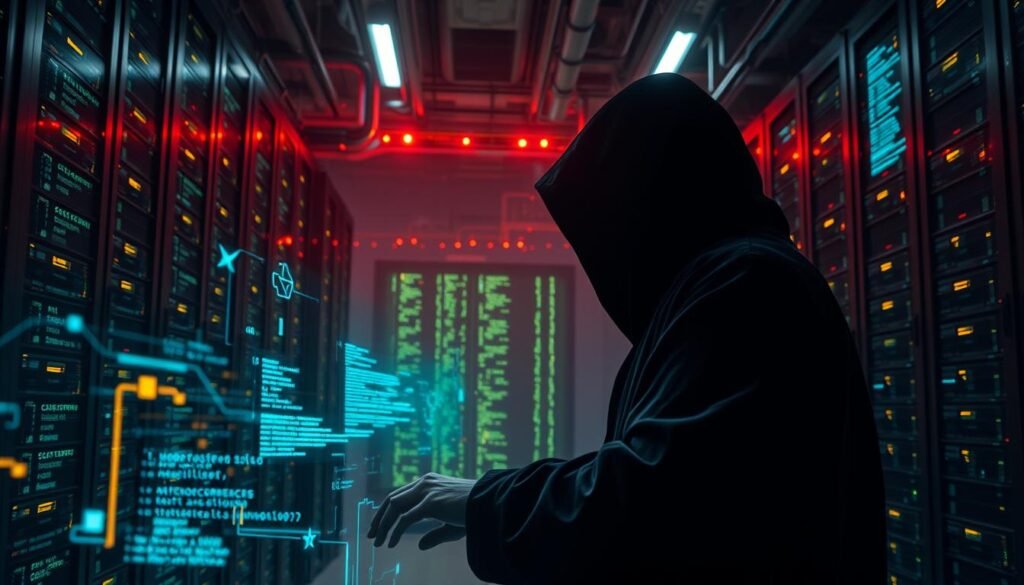Cyberattacks happen every 39 seconds worldwide. By 2025, cybercrime damages will hit $10.5 trillion annually. This is more than all illegal drugs traded globally.
Your company faces a huge security challenge. AI malware detection systems fight against AI-powered ransomware. Criminals sell ransomware like software subscriptions. Quantum computers can break old encryption methods.
The cybersecurity world has changed a lot in five years. Attackers use AI to make malware that adapts quickly. They rent tools for $40 a month. Soon, quantum computers will break encryption in minutes.
It’s vital to understand these new threats. You need to know how AI ransomware will target you. Prepare for ransomware-as-a-service and quantum computing attacks.
Key Takeaways
- AI-powered cyberattacks will become the primary threat vector by 2025, requiring advanced AI malware detection capabilities
- Ransomware-as-a-service platforms make sophisticated attacks accessible to low-skill criminals for minimal cost
- Quantum computing will render current encryption methods obsolete within the next decade
- Organizations must adopt proactive security measures instead of just reacting
- The mix of AI, quantum computing, and cybercrime poses huge security challenges
The Evolving Landscape of Cyber Threats in 2025
The world of cyber threats is changing fast as we move more online. Your business is facing new dangers as hackers find ways to use new tech and connect systems. It’s key to know these threats to keep your digital stuff safe.
Digital Transformation and New Attack Vectors
Going digital opens up chances and risks for your company. With 5G, IoT, and cloud, hackers find new ways in. Supply chain attacks target vendors and software, aiming at many businesses at once. Remote work has made it harder to keep endpoints safe.
The Convergence of Emerging Technologies in Cybercrime
Cybercriminals use AI, machine learning, and automation for smart attacks. These tools help them find weaknesses, make fake emails, and dodge security systems. State-sponsored cyber warfare groups mix old-school hacking with new tech, making threats hard to block.
| Technology | Criminal Application | Risk Level |
|---|---|---|
| AI/ML | Automated vulnerability scanning | Critical |
| 5G Networks | Increased attack speed | High |
| IoT Devices | Botnet creation | High |
| Cloud Services | Data exfiltration | Critical |
Global Threat Intelligence Predictions
Big names like CrowdStrike, Mandiant, and Palo Alto Networks see big changes in threats for 2025. They say state-sponsored cyber warfare will hit critical spots and money systems more. Supply chain attacks will jump, hitting software and cloud services. Get ready for ransomware that steals and encrypts data, asking for money twice.
AI Malware Detection, AI-Powered Ransomware Trends, Ransomware-as-a-Service
The world of cybersecurity has become an AI battle. Attackers and defenders use advanced machine learning. Ransomware groups now use AI to make their attacks worse. Security teams are working hard to keep up with these new threats.
Machine Learning Models for Advanced Threat Detection
Your company’s defense against malware depends on machine learning. These algorithms look at millions of code patterns in real-time. They spot threats that traditional methods miss.
Neural networks analyze file attributes, network traffic, and system behaviors. This helps catch threats that old antivirus software can’t handle.
Evolution of Ransomware-as-a-Service Business Models
Groups like LockBit and BlackCat offer subscription services for ransomware. They provide:
- Complete attack toolkits with customizable payloads
- Payment processing infrastructure
- Negotiation support and victim communication portals
- Revenue sharing models typically splitting profits 70-30
AI vs AI: The Detection and Evasion Battle
Attackers use AI to test their malware against detection systems. This means your automated systems face AI-made threats. These threats are designed to avoid detection.
Cybercriminals also use AI to create fake phishing threats. These threats can change based on how victims react. This makes it harder for traditional security training to work.
The Rise of Quantum Computing Threats
Quantum computing is a big change in how computers work. It could break the security you have now. Today’s encryption, like RSA and ECC, might not last when quantum computers get better.
Big tech companies like IBM and Google are working fast to make quantum computers. They think these computers could break encryption in the next 10 years. This means you need to switch to quantum-safe encryption fast.
Cybercriminals have a bad plan. They’re collecting encrypted data now, hoping to break it later with quantum computers. Your money, ideas, and personal info could be at risk soon.
Finding people who know about quantum computing and security is hard. You need experts who can:
- Check if your encryption is safe
- Use new quantum-safe encryption
- Plan for future security needs
- Make plans to switch to new security
You must act now to protect against quantum threats. Waiting for quantum computers to become common is not an option. Being ready for new encryption standards helps keep your data safe now and in the future.
Zero Trust Security Models: Your Organization’s New Defense Framework
Your organization’s cybersecurity needs a big change in 2025. Old security methods can’t stop new threats. Zero trust security models say: never trust, always check. They think no one or thing is safe by default, inside or outside your network.
Implementing Continuous Verification Protocols
Continuous checking is key to zero trust. Your systems should check users at every access point, not just when they log in. Using multi-factor authentication and behavior checks creates flexible security profiles. If something odd happens, AI can ask for more checks.
Microsoft Azure AD and Okta help make these checks work across your company.
Microsegmentation Strategies for Enhanced Protection
Microsegmentation breaks your network into small, safe areas. Each area has its own security rules. This makes it hard for attackers to move around if they get in.
Tools like Illumio and Guardicore make this easy. They adjust to your network’s changes automatically.
| Microsegmentation Tool | Key Features | Best For |
|---|---|---|
| Illumio Core | Real-time application mapping | Large enterprises |
| Guardicore Centra | Process-level visibility | Data centers |
| Cisco Tetration | AI-powered policy recommendations | Multi-cloud environments |
Identity-Based Security Architecture
In zero trust, identity is your main defense. Every user, device, and app gets its own digital ID. Access is based on who you are, where you are, and what you’re using.
This way, you get the right access without slowing down work.
Supply Chain Attacks: The Weakest Link in Your Security
Your organization’s cybersecurity is only as strong as its weakest vendor. Supply chain attacks have become a favorite weapon for cybercriminals. They target trusted software providers to infiltrate thousands of organizations at once. These attacks exploit the trust between companies and their technology partners, leading to a domino effect of breaches.
The SolarWinds breach infected over 18,000 organizations through a single compromised software update. The Kaseya VSA attack paralyzed 1,500 businesses worldwide. These incidents show how attackers use supply chain vulnerabilities to maximize their impact with minimal effort.
Modern AI-powered ransomware trends show criminals targeting software vendors and managed service providers. These sophisticated attacks use machine learning to find the most valuable targets in supply chains. They then automate the infection process across connected networks.
| Attack Vector | Risk Level | Protection Strategy |
|---|---|---|
| Software Updates | Critical | Code signing verification |
| Third-party APIs | High | API security monitoring |
| Cloud Services | High | Vendor risk assessments |
| Hardware Components | Medium | Supply chain audits |
Protecting against supply chain attacks requires implementing Software Bill of Materials (SBOM) tracking and continuous vendor monitoring. You need to know every component your systems rely on, from open-source libraries to commercial software packages. Regular security assessments of your vendors and real-time monitoring of their security posture can help detect compromises before they impact your organization.
State-Sponsored Cyber Warfare and Geopolitical Implications
State-sponsored cyber warfare is a big worry for countries everywhere. Governments back APT groups with advanced tools and plans. These groups mix old spy tricks with new ransomware to get what they want.
Nation-State Attack Patterns and Motivations
Groups like Lazarus, APT28 (Fancy Bear), and APT29 (Cozy Bear) have their own ways of working. Lazarus, from North Korea, goes after money and disrupts things. APT28 and APT29, from Russia, spy on governments and key places.

They use tactics like fake emails, zero-day bugs, and hacking into supply chains. They want money, power, and military wins.
Critical Infrastructure Vulnerabilities
Power plants, water systems, and hospitals are big targets. The 2021 Colonial Pipeline hack showed how easy it is to hit energy systems. Old systems in water plants are also at risk.
International Cybersecurity Cooperation Efforts
The Budapest Convention is key for fighting cyber crimes worldwide. The UN helps countries share info to fight ransomware and other big threats. The EU’s NIS Directive helps countries work together against cyber attacks.
Phishing Deepfake Threats: When You Can’t Trust Your Eyes
The rise of artificial intelligence has opened a new danger in cybercrime. Now, criminals can mimic CEOs and other executives with great accuracy. These attacks mix old phishing tricks with AI-made voices and videos, tricking even the most careful employees.
Deepfake business email scams have jumped by 230% in 2024. Thieves use AI to mimic voices from speeches, earnings calls, and social media. They then ask employees for urgent money transfers or data. One Fortune 500 company lost $35 million after their finance team got a fake video call from what seemed like their CEO.
| Detection Method | Effectiveness Rate | Implementation Cost |
|---|---|---|
| Blockchain Verification | 94% | $15,000-$50,000 |
| Biometric Authentication | 89% | $10,000-$30,000 |
| AI Detection Tools | 78% | $5,000-$20,000 |
Your company needs automated incident response systems to fight these threats. New tools check voice patterns, facial movements, and behavior in real-time. Companies like Microsoft and Google have made systems to catch suspicious messages early. But, training your team to check requests through different ways is your best defense against phishing deepfake threats.
The Cybersecurity Talent Shortage Crisis
Your organization is facing a big challenge in 2025. It’s hard to find skilled cybersecurity professionals to protect your digital assets. The cybersecurity talent shortage is severe, with 3.4 million job openings worldwide, according to ISC2’s Cybersecurity Workforce Study. This shortage leaves your company open to cyber threats.
Skills Gap Analysis and Industry Demands
The skills needed by your security team have changed a lot. Cloud security skills are now top priority as companies move to hybrid environments. DevSecOps knowledge is key for integrating security into development. Threat hunting skills help teams stay ahead of cyber threats.
| In-Demand Skills | Average Salary Range | Time to Fill Position |
|---|---|---|
| Cloud Security Architect | $145,000 – $195,000 | 4-6 months |
| DevSecOps Engineer | $130,000 – $175,000 | 3-5 months |
| Threat Hunter | $125,000 – $165,000 | 5-7 months |
| Zero Trust Architect | $140,000 – $185,000 | 4-6 months |
Upskilling and Reskilling Initiatives
Training providers like SANS Institute and CompTIA are expanding their programs to tackle the cybersecurity talent shortage. Universities are working with companies to offer special degrees. Your IT staff can also get security training through bootcamps on zero trust security models and cloud protection.
Leveraging AI to Augment Security Teams
Artificial intelligence boosts your team’s work by automating simple tasks. AI tools handle log analysis, initial threat triage, and pattern recognition. This lets your team focus on planning and handling complex incidents while keeping your systems secure with zero trust security models.
Automated Incident Response Systems and Real-Time Threat Mitigation
When a security breach happens, time is of the essence. How fast your team responds can prevent a small issue from becoming a big problem. Automated incident response systems are key to improving your security.
Platforms like Splunk Phantom, IBM Resilient, and Palo Alto Cortex XSOAR change the game. They use AI malware detection to spot threats fast and act quickly without needing a person.
Think of automated incident response as a digital team that works around the clock. When it spots something suspicious, it:
- Isolates infected devices from your network
- Blocks malicious IP addresses automatically
- Collects forensic evidence for investigation
- Alerts your security team with detailed context
Working with SIEM systems makes your defense stronger. Machine learning looks at millions of security events. This cuts down false positives by up to 70% compared to old methods.
Automation has made response times much faster. What used to take hours now takes minutes or seconds. Your automated incident response playbooks handle common threats like phishing and malware without needing a person.
This quick action is vital against advanced threats that use AI to evade detection. By automating simple tasks, your team can tackle harder threats that need human smarts and strategy.
Quantum-Resistant Encryption: Preparing for the Post-Quantum Era
The clock is ticking for quantum computing to arrive. Your current encryption is at risk. Quantum computers can break today’s encryption in minutes. This means your data could be stolen by cybercriminals using AI.
It’s time for organizations to switch to quantum-resistant encryption. This is urgent to avoid a big problem.
Current Encryption Vulnerabilities
Today’s RSA and elliptic curve cryptography are not safe against quantum computers. They work well now but won’t in the future. Quantum computers can solve problems that classical computers can’t.
Shor’s algorithm will break these algorithms. This puts financial and personal data at risk.
NIST Post-Quantum Cryptography Standards
In 2022, NIST picked four quantum-resistant encryption algorithms. CRYSTALS-Kyber is for general encryption. CRYSTALS-Dilithium, FALCON, and SPHINCS+ handle digital signatures.
Google is already testing CRYSTALS-Kyber in Chrome. This shows these solutions work in real life.
| Algorithm | Purpose | Security Level |
|---|---|---|
| CRYSTALS-Kyber | Key Encapsulation | 128-256 bit |
| CRYSTALS-Dilithium | Digital Signatures | 128-256 bit |
| FALCON | Digital Signatures | 128-256 bit |
Implementation Roadmaps for Organizations
Begin by checking your current encryption and finding what’s most important. Use a mix of old and new encryption during the switch. Test new methods in safe areas before using them everywhere.
Experts say we’ll see a big change by 2030. You have a short time to protect against AI threats.
Cloud Security Challenges in the Multi-Cloud Environment
Managing security across multiple cloud platforms is tough. You have to protect your data on AWS, Azure, and Google Cloud. Each platform has its own security tools and practices.
The shared responsibility model can confuse who’s in charge. Cloud providers protect the infrastructure, but you must secure your data and apps. This gets complicated with platform-specific services.
Misconfigurations are a big reason for cloud breaches. Simple errors like public storage buckets or weak passwords can be a big risk. Cybercriminals look for these weaknesses, selling access through ransomware-as-a-service.
Cloud Security Posture Management (CSPM) tools help keep an eye on your environments. They check for:
- Misconfigured storage permissions
- Excessive user privileges
- Unencrypted data transfers
- Outdated security patches
Your multi-cloud strategy needs unified security policies. Without them, attackers can find weak spots. This is even more critical when third-party vendors access your cloud, risking supply chain attacks.
IoT and Edge Computing Security Vulnerabilities
The Internet of Things (IoT) and edge computing are growing fast. This creates new security risks that need your quick attention. With billions of devices connected, hackers see big targets for attacks.
These threats are serious, even more so when used in state-sponsored cyber attacks on key infrastructure.
Securing Distributed Networks
Your IoT networks are at risk from advanced botnets. These can attack thousands of devices at once. The Mirai botnet shows how hackers use weak IoT devices for big attacks.
To keep your networks safe, you need strong security plans. This includes isolating devices, segmenting networks, and encrypting edge node communications.

Device Authentication and Management
Keeping your IoT devices secure means strong authentication. Tools like Microsoft Azure IoT Hub and AWS IoT Core help manage devices. They offer ways to secure devices, check their health, and update them remotely.
| IoT Management Platform | Key Security Features | Best Use Cases |
|---|---|---|
| Microsoft Azure IoT Hub | X.509 certificates, device twins, automatic provisioning | Enterprise deployments, industrial IoT |
| AWS IoT Core | Mutual TLS authentication, fine-grained permissions | Scalable consumer IoT, smart cities |
| Google Cloud IoT Core | JWT tokens, device registry, audit logging | Data analytics, machine learning integration |
Real-Time Threat Detection at the Edge
Edge computing needs special threat detection that works without the cloud. Your edge security must spot unusual behavior, phishing threats, and act fast. Zero-trust at the edge checks every device interaction, stopping threats in their tracks.
Regulatory Compliance and Privacy Laws in 2025
Your organization is dealing with a lot of privacy rules in 2025. The European Union’s AI Act has strict rules for AI systems. The United States is introducing a big privacy law. These laws mean big changes in how you handle personal data.
Finding the right cybersecurity talent is hard. Your team must follow special rules for healthcare, finance, and more. They also need to use zero trust security models. Tools that help with compliance can save a lot of time.
Now, building data protection into your systems is key. This matches well with zero trust security, which checks every access request. It helps keep data safe.
| Regulation | Key Requirements | Maximum Penalty |
|---|---|---|
| EU AI Act | Risk assessments, transparency obligations | €35 million or 7% global revenue |
| US Federal Privacy Act | Consumer rights, data minimization | $42,530 per violation |
| California Privacy Rights Act | Opt-out rights, annual audits | $7,500 per intentional violation |
Regulators are getting stricter. Cross-border data transfers are under close watch. You must show you’re always following the rules. With a talent shortage, you need smart tools to help your team.
Conclusion
The world of cybersecurity in 2025 is full of big challenges. AI attacks are getting smarter every day. Nation-states are going after our key systems. And, deepfakes are making it hard to tell what’s real.
You need a new way to think about security. Using AI to fight back is key. Zero trust checks every user and device all the time. And, quantum-resistant encryption keeps your data safe from future threats.
But, it’s not just about the tech. Your team needs to learn about AI and machine learning. You must switch to quantum-resistant encryption soon. And, your systems should work with threat data from top companies.
It’s time to start building your defenses. Cybercriminals won’t wait for you. So, begin now to stay safe.



